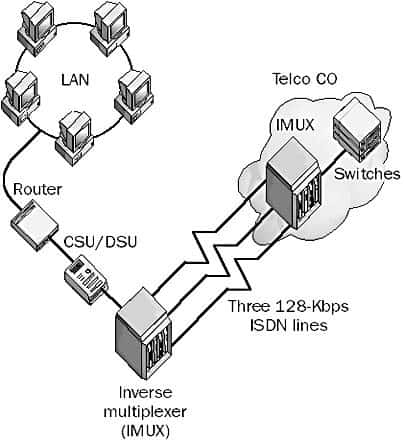Definition of Inverse Multiplexing in Network Encyclopedia.
What is Inverse Multiplexing?
Inverse Multiplexing is a networking and telecommunications technique of combining the bandwidths of a number of digital lines into a single virtual pathway for high-speed communication. Inverse multiplexing is the opposite of multiplexing, which combines data transmissions from multiple pieces of data terminal equipment (DTE) into a single digital communication channel.
How it works
You can connect a device called an inverse multiplexer, or IMUX, to the termination of several leased digital lines to create a single virtual connection with a bandwidth equal to the sum of the bandwidths of the individual lines. Inverse multiplexing can be used to aggregate the bandwidth of digital data service (DDS), switched 56, Integrated Services Digital Network (ISDN), or T1 and higher T-carrier services into a single high-bandwidth DTE interface. You can then connect this DTE interface to customer premises equipment such as routers or CSU/DSUs (Channel Service Unit/Data Service Units), which are connected to the customer’s network.

Inverse multiplexing requires an IMUX at both the customer premises and the telco central office (CO). When several ISDN subchannels are multiplexed into a single high-speed channel, a connection is initiated when the customer’s IMUX dials a number to establish a connection with the CO IMUX.
Once a single ISDN subchannel is established, the customer IMUX dials the remaining numbers and establishes the additional ISDN subchannels. Once all the subchannels are up, a protocol called Bandwidth On Demand Interoperability Group (bonding) establishes synchronization between the two stations using a handshaking mechanism to resolve any delays between the subchannels.
These delays are primarily the result of the different circuit-switched communication subchannels having physical paths of different lengths, even though they have the same two endpoints. The bonding protocols also ensure that data sent over each subchannel arrives at its destination in the correct order.
The main advantage of inverse multiplexing is that it is often less expensive to lease several low-speed digital lines and inverse multiplex them together than to lease a single high-speed digital line with the same aggregate bandwidth. Inverse multiplexing is also useful in areas where high-speed digital services such as T1 are not readily available.